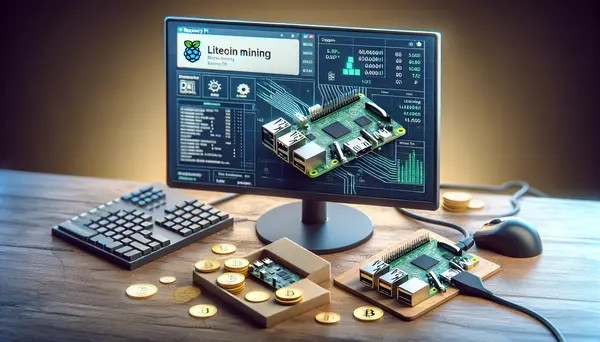Ledger
Ledger
In the world of Bitcoin mining, there are several key elements that you must understand. One of these is the ledger. Let's take a closer look to uncover what a ledger is and why it's an essential part of the Bitcoin mining universe.
What is a Ledger in Bitcoin Mining?
The term ledger refers to a digital record of all transaction data in the Bitcoin network. When someone sends or receives Bitcoin, this transaction is recorded on the Bitcoin ledger. This is not just any ledger; it is a public ledger, meaning it's open and visible to everyone within the Bitcoin network.
Why is a Ledger Important in Bitcoin Mining?
Every transaction that occurs in the Bitcoin universe leaves a mark on the ledger. This is crucial for the transparency and security of the network. The ledger guarantees that all transactions are visible, making it nearly impossible to cheat or forge transactions. This transparency is what helps maintain trust within the Bitcoin community. The ledger's role in Bitcoin mining is to validate all transactions and ensure they're legitimate.
How Does a Ledger Work?
The ledger operates on a technology called blockchain. In simple terms, a blockchain is a chain of blocks, where each block contains a list of transactions. This makes the ledger tamper-proof since altering a single transaction would mean changing all the blocks after it - a task that's computationally demanding, making it practically impossible.
Key Features of a Bitcoin Ledger
The Bitcoin ledger has some unique features. Firstly, it's decentralized. This means there's no central authority controlling it - an attribute that gives Bitcoin its freedom. Second, the ledger is immutable - once a transaction is recorded, it can't be changed or deleted. This feature ensures every coin's traceability, fostering trust in the system. Lastly, the ledger keeps Bitcoin secure by making all transactions public and easy to trace.
Summary
In conclusion, the ledger plays a crucial role in the Bitcoin mining process. It's a public record of all transactions, ensuring transparency and fostering trust within the Bitcoin community. Its decentralized, immutable nature keeps Bitcoin free from control and secure from forgery.
Blog Posts with the term: Ledger

Cloud mining allows individuals to lease processing power from remote data centers for cryptocurrency mining, offering convenience and lower upfront costs but potentially reduced earnings and risks of scams. Hardware mining involves owning equipment with greater control and profit potential...

This guide provides a comprehensive overview of setting up an Ethereum mining rig, covering essential components like GPUs and motherboards, as well as key concepts such as Proof of Work (PoW) and hashrate. By the end, readers will understand how...

USDT (Tether) is a stablecoin pegged to the US Dollar, offering stability and liquidity in the cryptocurrency market. Unlike traditional cryptocurrencies that are mined, USDT can be earned through methods like liquidity mining, staking, and cloud mining; setting up involves...

Monero mining involves validating transactions using computational power, with miners rewarded through a combination of decreasing block rewards and transaction fees. The unique tail emission mechanism ensures perpetual miner incentives by stabilizing the reward at 0.6 XMR per block once...

The article compares solo and pool mining for Monero, detailing their respective advantages and disadvantages. Solo mining offers full block rewards but is resource-intensive with inconsistent payouts, while pool mining provides more consistent earnings by combining computational power at the...

Litecoin mining, similar to Bitcoin but using a different hashing algorithm called Scrypt, can be done with Raspberry Pi. Despite not delivering high-performance output like dedicated mining rigs or high-end computer systems, the low-cost and energy-efficient Raspberry Pi is an...

XRP, created by Ripple Labs in 2012, is designed for fast and cost-effective cross-border transactions using a semi-centralized ledger maintained by independent validator nodes. Unlike Bitcoin and Ethereum, XRP cannot be mined as all its tokens were pre-mined at inception;...

This article provides a comprehensive guide on using MetaMask for Ethereum mining, covering the setup process, connecting to mining pools, and optimizing configurations. By following these steps, beginners can efficiently start their Ethereum mining journey with enhanced security and performance....

USDT DeFi Mining allows users to earn rewards by leveraging decentralized finance protocols using the stablecoin USDT, offering benefits like stable returns and passive income but also posing risks such as smart contract vulnerabilities and market volatility. This guide covers...

Qatar is emerging as a potential hub for crypto mining, leveraging its natural gas reserves and sustainable energy initiatives to offer cost-effective power solutions while developing legal frameworks to regulate the industry. Challenges include regulatory clarity, environmental sustainability, infrastructure scaling,...

Australia has become a significant player in crypto mining due to its vast land, abundant renewable energy resources, and technological advancements. However, miners face challenges such as high initial setup costs for renewable energy, regulatory uncertainty, environmental concerns, market volatility,...

ETH mining withdrawal involves transferring mined Ethereum from a mining pool to your personal wallet, which is essential for security, liquidity, usage flexibility, and ownership. To withdraw ETH successfully, log in to your mining pool account, verify your balance meets...

The article explores the profitability of XRP mining, highlighting its unique consensus algorithm and how it differs from traditional cryptocurrencies like Bitcoin. It covers key factors influencing profitability such as transaction fees, network activity, hardware costs, energy consumption, market value...

The article provides a comprehensive guide to mining XRP on Android devices, detailing the necessary tools and steps for setup, including choosing a reliable mining app and ensuring device optimization. It highlights the accessibility, low entry cost, potential for passive...

